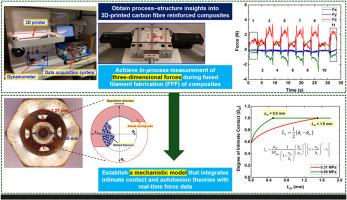Mechanistic modelling of fused filament fabrication process for carbon fibre reinforced composites
IF 9.8
1区 材料科学
Q1 MATERIALS SCIENCE, COMPOSITES
引用次数: 0
Abstract
This study develops a mechanistic model aided by a 3D dynamometer to achieve in-process characterisation of three-dimensional forces during a fused filament fabrication (FFF) process, enabling a deeper insight to the FFF process for carbon fibre reinforced composites. First, a 3D printing system integrated with a dynamometer of high precision was developed to measure the three-dimensional loads during the fabrication of both short carbon fibre (SCF) and continuous carbon fibre (CCF) reinforced polyamide (PA6) with the FFF process. Then, both microstructural and mechanistic studies addressing the intimate contact and autohesion mechanisms during the FFF processes were conducted to explore the process-structure relationships of the printed composites. The results show that the compacting force of SCF/PA6 is much smaller than that of CCF/PA6 during the deposition. A compressive pressure of 1 MPa from the printing nozzle at a nozzle temperature of 252 °C and a deposition speed of 15 mm/s proves just sufficient for achieving complete intimate contact in the CCF/PA6 composite by the analysis of the mechanistic model. Microstructural characterisations of 3D printed CCF/PA6 composites also reveal a difference in the compacting force recorded in printing adjacent filaments associated with inaccurate positioning of printing paths, leading to poor fusion quality and existence of voids. Further, the effects of reduced nozzle height on the resultant deposition pressure and the printing quality of CCF/PA6 composites were also investigated in this study.

碳纤维增强复合材料熔丝加工过程的力学建模
本研究开发了一个由3D测力仪辅助的机械模型,以实现熔丝制造(FFF)过程中的三维力的过程表征,从而更深入地了解碳纤维增强复合材料的FFF过程。首先,开发了一个集成高精度测功机的3D打印系统,用于测量短碳纤维(SCF)和连续碳纤维(CCF)增强聚酰胺(PA6)在FFF工艺下的三维载荷。然后,对FFF过程中的密切接触和自粘机制进行了微观结构和力学研究,以探索打印复合材料的工艺结构关系。结果表明,SCF/PA6在沉积过程中的压实力明显小于CCF/PA6;机理模型分析表明,在252℃的打印喷嘴压力为1 MPa、沉积速度为15 mm/s的条件下,CCF/PA6复合材料可以实现完全的紧密接触。3D打印的CCF/PA6复合材料的微观结构特征也揭示了打印相邻细丝时记录的压实力的差异,这与打印路径定位不准确有关,导致融合质量差和存在空洞。此外,本文还研究了喷嘴高度的降低对CCF/PA6复合材料沉积压力和打印质量的影响。
本文章由计算机程序翻译,如有差异,请以英文原文为准。
求助全文
约1分钟内获得全文
求助全文
来源期刊

Composites Science and Technology
工程技术-材料科学:复合
CiteScore
16.20
自引率
9.90%
发文量
611
审稿时长
33 days
期刊介绍:
Composites Science and Technology publishes refereed original articles on the fundamental and applied science of engineering composites. The focus of this journal is on polymeric matrix composites with reinforcements/fillers ranging from nano- to macro-scale. CSTE encourages manuscripts reporting unique, innovative contributions to the physics, chemistry, materials science and applied mechanics aspects of advanced composites.
Besides traditional fiber reinforced composites, novel composites with significant potential for engineering applications are encouraged.
 求助内容:
求助内容: 应助结果提醒方式:
应助结果提醒方式:


